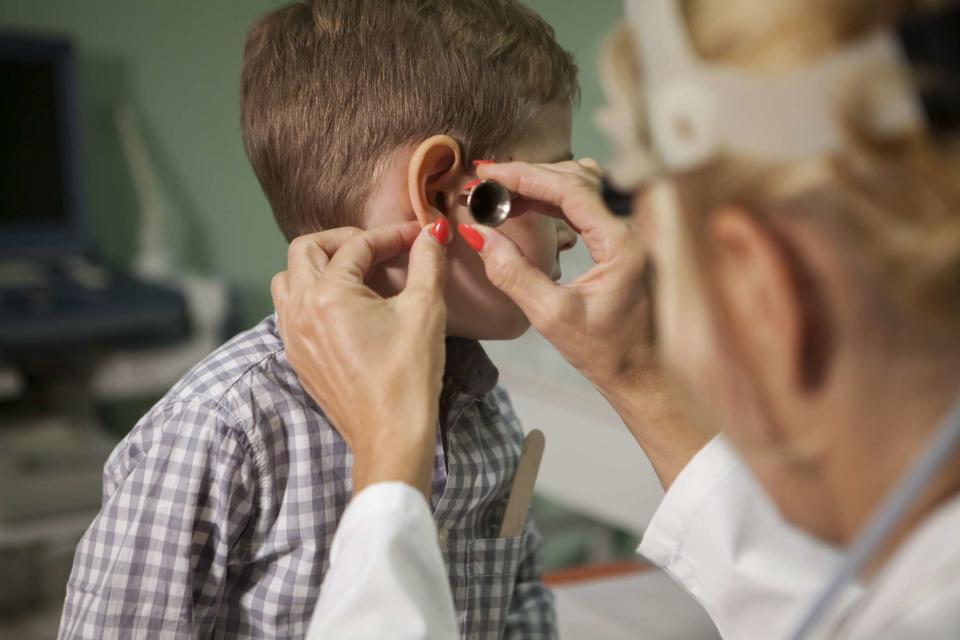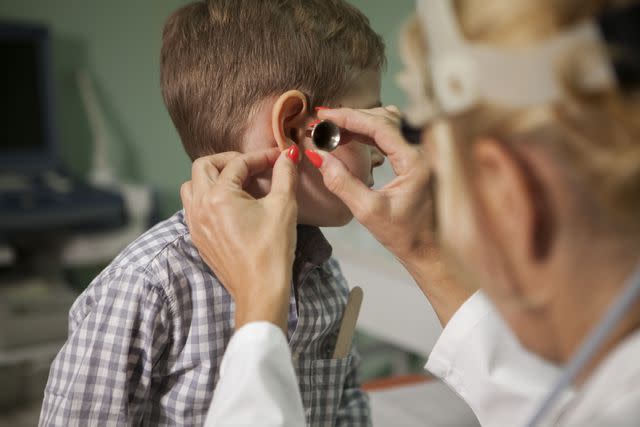Purpose of Mastoidectomy Surgery
A Common Procedure to Remove Mastoid Air Cells From Chronic Ear Infection

M_a_y_a / Getty Images
Medically reviewed by John Carew, MD
Mastoidectomy is a relatively major surgery that removes thin, bony partitions between hollow air pockets (mastoid air cells) within the skull's mastoid bone, which is located just behind the ear.
The purpose of a mastoidectomy is to remove any part of an infected or diseased mastoid. The damaged mastoid may occur due to an abnormal skin growth in the middle ear called a cholesteatoma, or a middle ear infection (otitis media) may spread to the hollow air pockets in the skull's mastoid bone.
In these cases, the surgeon performing a mastoidectomy would use a drill to remove the bony partitions around infected mastoid air cells and clear the infection.
This article will discuss the different types of mastoidectomy surgery, which type is considered more serious surgery, what happens during the operation, post-op care, and more.

M_a_y_a / Getty Images
Mastoidectomy: What Is the Mastoid?
The mastoid portion of the skull's temporal bone sits just behind the ear. This part of the skull bone has many air-filled cavities called mastoid air cells.
In this context, the term "cells" refers to the empty spaces or air pockets within the mastoid, not living biological cells. The pattern of mastoid air cells resembles the irregularly shaped air bubbles inside an English muffin.
You can feel the ridge of your skull's mastoid bone under the scalp by running your fingertips along the curve of your outer ear near the hairline. This area behind the ear is where a surgeon would make a C-shaped incision and peel back the skin to perform mastoidectomy surgery within the honeycomb-like mastoid bone.
The air-filled cavities within the mastoid bone can harbor infection or get invaded by a bone-eroding cholesteatoma skin growth that starts in the middle ear and makes its way into the mastoid air cells. When mastoid air cells are diseased or infected, it's called mastoiditis.
The main purpose of mastoidectomy surgery is to remove some or all of the little chambers (mastoid air cells) that can get filled with pus-like secretions and turn into mastoid abscesses. Removing the mastoid air cells also gives a cholesteatoma fewer places to get trapped and fester.
If not treated with a mastoidectomy, the invasive cholesteatoma in the mastoid bone's air cells can make its way into brain tissue, causing meningitis or other life-threatening complications.
Because a mastoidectomy creates space within the mastoid bone behind the ear, this surgical procedure is also used during cochlear implant surgery (inserting an electronic device to aid in hearing).
Types of Mastoidectomy
There are two major types of mastoid surgery, canal-wall-up, and canal-wall-down, which are:
Canal-wall-up (CWU): Typically, people have a canal-wall-up mastoidectomy to treat their first episode of acute mastoiditis. This surgical procedure preserves the ear canal. CWU also leaves much of the mastoid's anatomy intact and requires fewer postoperative checkups.
Canal-wall-down (CWD): This surgery is more extensive than a CWU mastoidectomy. CWD does not preserve the ear canal but is the gold standard for people with extensive cholesteatoma. This type of mastoidectomy alters the mastoid's anatomy by creating an opening, which has pros and cons.
For anyone wondering if mastoidectomy is major surgery, the answer is yes. But mastoidectomies can vary in complexity. Generally, a canal-wall-down mastoidectomy is more radical and serious than the canal-wall-up type.
What Is Tympanoplasty with Mastoidectomy?
Tympanoplasty surgery repairs a ruptured eardrum (tympanic membrane). Tympanoplasty with mastoidectomy, also called a tympanomastoidectomy, is when these two surgical procedures are performed back-to-back during the same operation.
The suffix "-ectomy" comes from the Greek word for "cutting out." As a medical term, "-ectomy" means "surgically removing a part of the body." Mastoidectomy "cuts out" part of the mastoid.
Mastoidectomy is a centuries-old procedure. In 1736, a French surgeon named Jean-Louis Petit performed the first known mastoidectomy to remove a mastoid abscess. Petit's writings describe using a miniature chisel and tiny hammer to break apart mastoid air cells filled with pus (purulent secretions) that had become encapsulated and compressed within the mastoid's honeycomb-like partitions.
Before the advent of antibiotics in the 20th century, mastoidectomies were commonly performed to drain infections or remove collections of pus (abscesses) from the mastoid bone's air cavities. This surgical procedure is less common in modern times because, in most cases, antibiotics can successfully treat a bacterial ear infection before pus-like drainage seeps into the mastoid's hollow air cells.
What Happens During a Mastoidectomy?
During a mastoidectomy, you will receive general anesthesia before a surgeon starts the procedure by making an incision behind the ear to access the mastoid bone.
Using a drill, the surgeon breaks apart and removes the honeycomb partitions around mastoid air cells containing infected or diseased material.
Once the diseased or infected air cells have been cut out and the mastoid cavity has been cleaned, the incision is closed, and you are taken to a recovery room.
A mastoidectomy usually takes about two to three hours. Some people go home the same day as their surgery, while others may spend the night in a hospital room during postoperative recovery and go home the next day.
Although mastoidectomies and tympanoplasty surgery can improve hearing in some people, middle ear surgeries also carry the risk of postoperative hearing loss.
Post-Op Mastoidectomy Care
Post-op mastoidectomy care can vary. After the procedure, you'll be given specific postoperative instructions and guidelines that should be followed closely.
In general, some common post-up guidelines are to avoid showering or letting any water in the ear for at least 48 hours after surgery and keeping your head elevated when lying down for a few weeks after surgery. You should also avoid "popping" your ears, blowing your nose, and sneezing with your mouth closed in the first few days after the operation.
How Long Is Mastoidectomy Recovery?
It usually takes six to 12 weeks to fully recover from a mastoidectomy. During this time, you should avoid air travel and swimming. Also avoid lifting heavy objects for at least three weeks after surgery.
Children can return to school one to three days after surgery. Most people can resume their daily routine and return to work after seven to 14 days.
The general prognosis (outlook) for mastoidectomy is good; most procedures are successful. However, outcomes and potential complications can vary depending on the extent of presurgical disease and the type of mastoidectomy performed.
For example, a canal-wall-down mastoidectomy usually has a longer recovery period than a canal-wall-up mastoidectomy and may require a long-term outpatient commitment.
Summary
The mastoid section of the skull’s temporal bone is a honeycomb-like structure with lots of little hollow compartments called mastoid air cells. Sometimes, these air-filled cavities get filled with disease-ridden gunk that seeps into the mastoid air cells when you have a chronic middle ear infection or an abnormal skin growth called a cholesteatoma.
Mastoidectomy removes diseased or infected mastoid air cells so a surgeon can clean out the area and make it more of an open space. When the mastoid bone is more open after mastoidectomy surgery, it’s harder for abnormal skin growths or pus to get stuck in the mastoid cavity because the partitions that once made tiny air pockets have been surgically removed.

